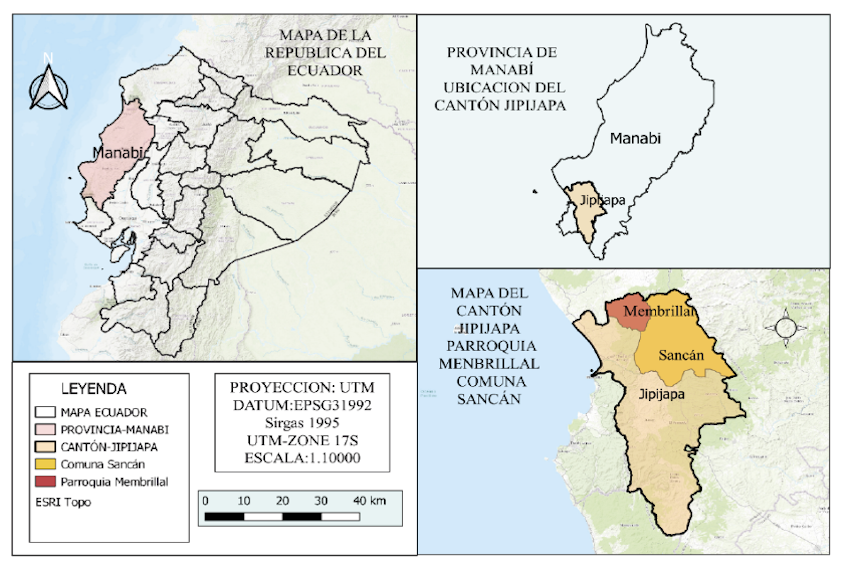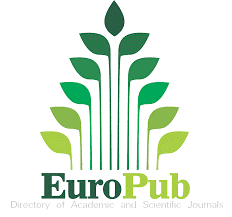Fire use in forestry vocation lands of Jipijapa canton, Manabí, Ecuador
Keywords:
Forest fires, integrated fire management, fire preventionAbstract
Over the last decades, both the number of forest fires and the area burned have increased worldwide. Reasons for this include climate change, population growth and the result of fire management policies that did not consider fire as an ecological and cultural factor. Many communities use it frequently and sometimes it gets out of control. The objective of this research was to analyse the use of fire in forestry vocation lands of Jipijapa canton, Manabí, Ecuador. Information from the Sancán commune and the Membrillal parish of this canton was used. The sampling unit was the agricultural producers and the population was delimited by people aged between 25 and 74 years old. The non-probabilistic technique of convenience sampling was applied and the sample size was calculated with the Decision Analyst STATSTM 2.0 software. A semi-structured questionnaire with open and closed questions was used to obtain the information. Statistical processing was carried out with SPSS version 22.0. The results show that 97.4 % of the respondents who work the land manually use fire to clear the land of weeds and crop residues, which they do mainly during the months of November and December. This work can be an important tool for decision making in the field of integrated fire management.References
Alanis Morales, H. E., Návar Chaidez, J. J. y Flores Garnica, J. G. (2009). Impacto de una quema controlada en la infiltración y el escurrimiento superficial en un bosque de pino. In Impactos ambientales de los incendios forestales (pp. 265–274). Mundi Prensa México, S. A. de C. V. https://www.researchgate.net/publication/281976771_Impacto_de_una_quema_controlada_en_la_infiltracion_y_el_escurrimiento_superficial_en_un_bosque_de_pino
Alcívar Cobeña, A. y Cedeño Luna, N. A. (2021). Usos tradicionales del fuego en las actividades agrícolas de la parroquia Convento, cantón Chone, Manabí, Ecuador [Trabajo de grado. Universidad Estatal del Sur de Manabí]. http://repositorio.unesum.edu.ec/handle/53000/3065
Araya Bravo, J., Duprat Sáez, C. y Parra Olave, M. (2009). Alternativas de reemplazo a las quemas de residuos agrícolas y forestales. In Corporación Nacional Forestal. Ministerio de Agricultura. Gobierno de Chile. https://www.prevencionincendiosforestales.cl/documento/alternativas-de-reemplazo-a-las-quemas-de-residuos-agricolas-y-forestales/
Bonfim, V. R., Ribeiro, G. A., Silva, E. y Braga, G. M. (2003). Diagnóstico do uso do fogo no entorno do Parque Estadual da Serra do Brigadeiro (PESB), MG. Revista Árvore, 27(1), 87–94. https://doi.org/10.1590/s0100-67622003000100012
Carroll, M. S., Edgeley, C. M. y Nugent, C. (2021). Traditional use of field burning in Ireland: History, culture and contemporary practice in the uplands. International Journal of Wildland Fire, 30(6), 399–409. https://doi.org/10.1071/WF20127
Casau, M., Ferreira Dias, M., Teixeira, L., Matias, J. C. O. y Nunes, L. J. R. (2022). Reducing Rural Fire Risk through the Development of a Sustainable Supply Chain Model for Residual Agroforestry Biomass Supported in a Web Platform: A Case Study in Portugal Central Region with the Project BioAgroFloRes. Fire, 5(3). https://doi.org/10.3390/fire5030061
Certini, G. (2005). Effects of fire on properties of forest soils: A review. Oecologia, 143(1), 1–10. https://doi.org/10.1007/s00442-004-1788-8
Da Silva Santos, A. M. (2010). Diagnóstico do uso do fogo em propriedades rurais nos limítrofes do município de Patos - PB [Trabajo de grado, Universidade Federal de Campina Grande]. http://bibliotecaflorestal.ufv.br/bitstream/handle/123456789/8336/2010_Diagn%c3%b3stico-do-uso-do-fogo-em-propriedades-rurais-nos-lim%c3%adtrofes-de-Patos-PB.pdf?sequence=1&isAllowed=y
De Assunção, R., Tetto, A. F. y Batista, A. C. (2017). O uso tradicional do fogo no assentamento Vale Verde, em Gurupi / TO. Espacios, 38(17). http://www.revistaespacios.com/a17v38n17/a17v38n17p19.pdf
Gobierno Autónomo Descentralizado Municipal de Jipijapa. (2015). Plan de Desarrollo y Ordenamiento Territorial cantón Jipijapa.
Gutiérrez Navarro, A., Garcìa Barrios, L. E., Parra Vázquez, M. y Rosset, P. (2017). De la supresión al manejo del fuego en la Reserva de la Biosfera La Sepultura, Chiapas: perspectivas campesinas. Región y Sociedad, 29(70). https://doi.org/10.22198/rys.2017.70.a329
Huertas Herrera, A., Baptiste Ballera, B. L. G., Toro Manríquez, M. y Huertas Ramírez, H. (2019). Manejo de la quema de pastizales de sabana inundable: Una mirada del pueblo originario Sáliva en Colombia. Chungará (Arica) Revista de Antropología Chilena, 51(1), 0–0. https://doi.org/10.4067/s0717-73562018005002401
IBM Corp. (2013). IBM SPSS Statistics for Windows, Version 22.0. Armonk, NY: IBM Corp.
NASA Prediction of Worldwide Energy Resources. (2022). NASA Prediction of Worldwide Energy Resources. https://power.larc.nasa.gov/data-access-viewer/
Nascimento, J. R. y Wiecheteck, M. (2014). Como Implementar La Política De Tierras De Vocación Forestal (Issue 1). https://doi.org/10.13140/RG.2.1.3866.4163
Organización de las Naciones Unidas para la Alimentación y la Agricultura. (2019). Strategy on Forest Fire Management (p. 17). Organización de las Naciones Unidas para la Alimentación y la Agricultura. https://www.fao.org/3/cb6816en/cb6816en.pdf
Ramos Rodríguez, M. P., Baque López, M. J., Jimenez González, A., Pionce Andrade, G. A. y Manrique Toala, T. O. (2018). Programa de comunicación sobre prevención de incendios forestales en el cantón Paján, Manabí, Ecuador. Perspectivas Rurales Nueva Época, 16(30), 91–115. https://doi.org/10.15359/prne.16-31.6
Ramos-Rodríguez, M. P., Cedeño-Cedeño, D. S., Batista, A. C., Jimenez-González, A., Manrrique-Toala, T. O. y Terro, A. F. (2021). Usos tradicionales del fuego en la Parroquia Ayacucho, Cantón Santa Ana, provincia Manabí, Ecuador. Revista Forestal Mesoamericana Kurú, 18(43), 41–52. https://doi.org/10.18845/rfmk.v19i43.5807
Reyes Chancay, J. E. (2022). Programa de comunicación sobre el uso del fuego y los incendios forestales en el cantón Jipijapa, Manabí, Ecuador [Trabajo de grado. Universidad Estatal del Sur de Manabí]. http://repositorio.unesum.edu.ec/handle/53000/3065
Rodríguez Trejo, D. A. (2001). Ecología del fuego en el ecosistema de Pinus hartewii Lindl. Revista Chapingo. Serie Ciencias Forestales y Del Ambiente, 7(2), 145–151. http://biblat.unam.mx/es/revista/revista-chapingo-serie-ciencias-forestales-y-del-ambiente/articulo/ecologia-del-fuego-en-el-ecosistema-de-pinus-hartewii-lindl
Rosero, J. y Osorio, I. (2013). Efectos de los incendios forestales en las propiedades del suelo. Estado del arte. Cuaderno Activa, 5, 59–67. https://doi.org/10.4067/s0718-50732020000200119
Secretaría de Producción Forestal. (2020). Manual de prevención de incendios forestales en plantaciones comerciales y sistemas agroforestales productivos. Ministerio de Agricultura y Ganadería.
Sofiyuddin, M., Suyanto, S., Kadir, S. y Dewi, S. (2021). Sustainable land preparation for farmer-managed lowland agriculture in Indonesia. Forest Policy and Economics, 130(June), 102534. https://doi.org/10.1016/j.forpol.2021.102534
Sousa Gomes, V. y Pauletto, D. (2018). Uso tradicional do fogo: Avaliação de queima controlada na agricultura de subsistência exercida na Reserva Extrativista Tapajós-Arapiuns. Revista Terceira Margem Amazônia, 3(11), 168–177. https://doi.org/10.36882/2525-4812.2018v3i11p%25p

Published
How to Cite
Issue
Section
License
Copyright (c) 2022 Bosques Latitud Cero

This work is licensed under a Creative Commons Attribution-NonCommercial-ShareAlike 4.0 International License.
This work is published under the Creative Commons Attribution-NonCommercial-ShareAlike 4.0 International (CC BY-NC-SA 4.0) license. This means that users may copy, distribute, and adapt the content, provided that proper credit is given to the authors and the journal. Commercial use of the material is not permitted. Additionally, any derivative work must be distributed under the same license. This license ensures open access to knowledge, promoting the dissemination and reuse of published works for non-commercial purposes, respecting authorship, and ensuring the free circulation of content under fair terms.




























